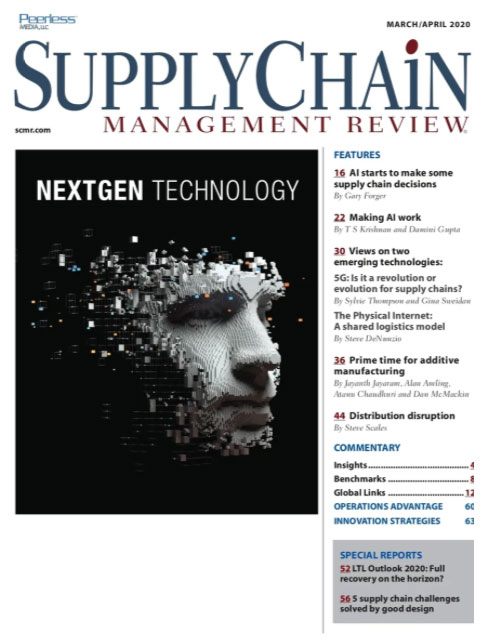Sorry, but your login has failed. Please recheck your login information and resubmit. If your subscription has expired, renew here.
March-April 2020
Are you ready for NextGen technologies? Just the other day, I had the opportunity to tour one of Amazon’s highly automated robotic fulfillment centers. I expected to be dazzled—and I was. But it wasn’t because of the automation. The tour was a reminder that there’s no question that NextGen technologies such as Artificial Intelligence, blockchain, robotics, 3D printing and 5G are going to be the differentiators in tomorrow’s supply chain. The question is: Are you ready? Browse this issue archive.Need Help? Contact customer service 847-559-7581 More options
BOOM! Did you know that every time you send an email, you cause an explosion? Don’t worry, we won’t tell anyone. Many people don’t realize it, but that’s the way the internet works.
At some point today, you probably sent an email. The moment you hit “send,” your email was broken into numerous packets. Those packets were then routed all over the world separately, probably to diverse interim locations and were ultimately routed to their destination where they were reassembled so that the message could be read by your recipient.
This process is called Transmission Control Protocol/Internet protocol, or “TCP/IP” for short. It really doesn’t matter that you’re using one internet provider, and the recipient is using another. Nor does it matter that you sent the email through Microsoft Outlook, and they’re reading it in Apple iMail. The delivery mechanism and network are agnostic.
If you think about it practically, as the sender, you don’t really care that this process has occurred. You just want the intended recipient to receive the email as quickly as possible, and in one piece. Nor does the recipient really care how it got to them; they just want to ensure they don’t miss an important message.

This complete article is available to subscribers only.
Log in now for full access or start your PLUS+ subscription for instant access.
SC
MR
Sorry, but your login has failed. Please recheck your login information and resubmit. If your subscription has expired, renew here.
March-April 2020
Are you ready for NextGen technologies? Just the other day, I had the opportunity to tour one of Amazon’s highly automated robotic fulfillment centers. I expected to be dazzled—and I was. But it wasn’t because… Browse this issue archive. Access your online digital edition. Download a PDF file of the March-April 2020 issue.BOOM! Did you know that every time you send an email, you cause an explosion? Don't worry, we won't tell anyone. Many people don't realize it, but that's the way the internet works.
At some point today, you probably sent an email. The moment you hit “send,” your email was broken into numerous packets. Those packets were then routed all over the world separately, probably to diverse interim locations and were ultimately routed to their destination where they were reassembled so that the message could be read by your recipient.
This process is called Transmission Control Protocol/Internet protocol, or “TCP/IP” for short. It really doesn't matter that you're using one internet provider, and the recipient is using another. Nor does it matter that you sent the email through Microsoft Outlook, and they're reading it in Apple iMail. The delivery mechanism and network are agnostic.
If you think about it practically, as the sender, you don't really care that this process has occurred. You just want the intended recipient to receive the email as quickly as possible, and in one piece. Nor does the recipient really care how it got to them; they just want to ensure they don't miss an important message.
SC
MR


Latest Supply Chain News
- Tech investments bring revenue increases, survey finds
- Survey reveals strategies for addressing supply chain, logistics labor shortages
- Israel, Ukraine aid package to increase pressure on aerospace and defense supply chains
- How CPG brands can deliver on supplier diversity promises
- How S&OP provides the answer to in-demand products
- More News
Latest Resources

 Explore
Explore
Software & Technology News
- Tech investments bring revenue increases, survey finds
- Survey reveals strategies for addressing supply chain, logistics labor shortages
- AI, virtual reality is bringing experiential learning into the modern age
- Humanoid robots’ place in an intralogistics smart robot strategy
- Tips for CIOs to overcome technology talent acquisition troubles
- Game on: Rethinking change management for the digital era
- More Software & Technology
Latest Software & Technology Resources

Subscribe

Supply Chain Management Review delivers the best industry content.

Editors’ Picks






